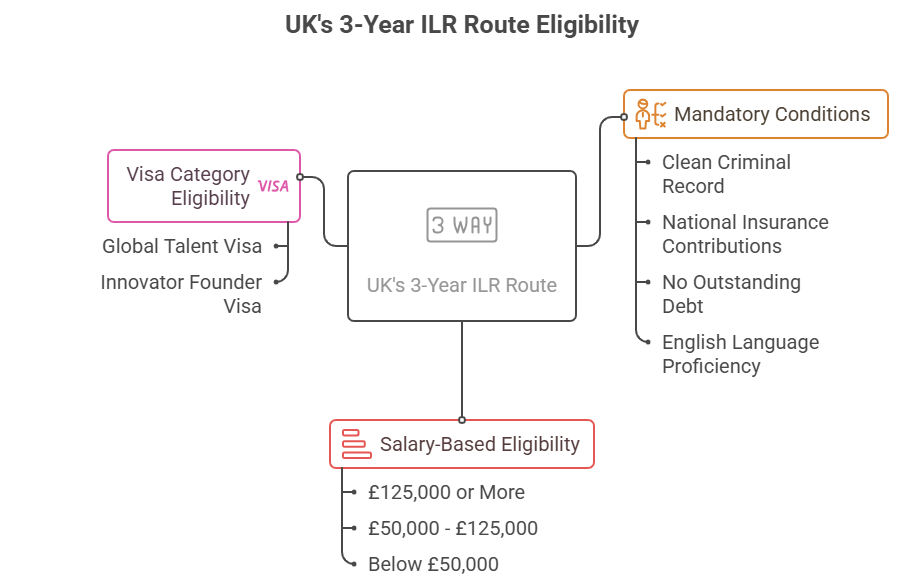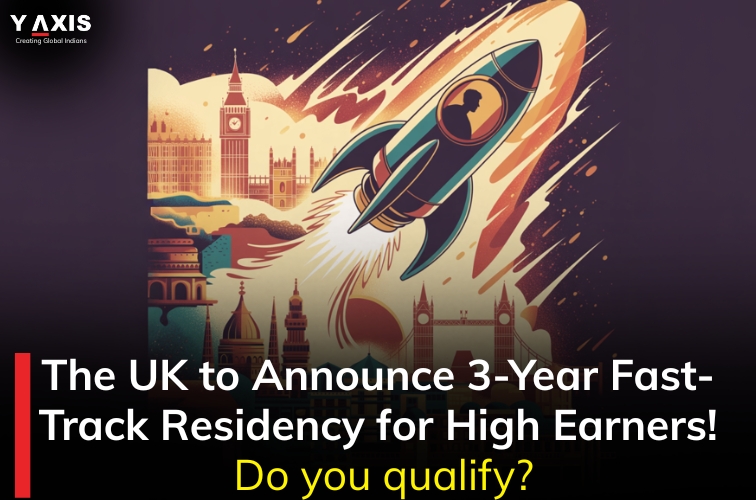Posted on November 21 2025
Breaking News! The UK plans to announce 3-Year Fast-Track Residency for High Earners! Do you qualify?
By , Editor
Updated November 21 2025
Highlights: 3-Year ILR Route Introduced for £125k+ Earners in the UK
- The UK has announced a major overhaul of its ILR (Indefinite Leave to Remain) system, linking residency timelines directly to income levels and visa categories.
- High earners making £125,000+ will now be eligible for fast-track ILR in just 3 years, instead of the current 5-year requirement
- An estimated 1.3 million to 2.2 million migrants could become eligible for ILR by 2030, according to Home Office projections.
- Entrepreneurs on Global Talent and Innovator Founder visas will also qualify for the 3-year fast-track settlement route.
- Lower earners will face a significantly longer 10-year baseline, with penalties potentially extending the ILR wait time to 15 or even 20 years.
*Want to work in the UK? Let Y-Axis guide you with the steps.
UK Plans 3-Year ILR for High Earners under New Residency Rules
The UK has announced a major proposal that could reshape how migrants qualify for permanent residency (Indefinite Leave to Remain or ILR). The government is introducing a new income-based pathway that fast-tracks high earners while increasing the waiting period for lower-income workers.
Under the proposed rules, individuals earning £125,000 or more will be able to apply for ILR in just three years, from the current five-year requirement. The same fast-track will also apply to leading innovators and entrepreneurs under the Global Talent visa and Innovator Founder visa routes, reflecting the UK’s commitment to attracting high-value professionals.
However, earners in the £50,000–£125,000 range will remain on the existing five-year ILR timeline, while those earning less than £50,000 will face a dramatically longer pathway.
According to the Home Office, 1.3 million to 2.2 million people are projected to become eligible for ILR by 2030 under the new framework, making clarity around these rules essential for migrants planning their future in the UK.
*Want to migrate to the UK? Sign up with Y-Axis to assist you with the process.
Who can apply for the UK’s 3-Year ILR Route under the New Rules?
The UK’s proposed ILR framework sets out new income-based timelines and core conditions that all migrants must meet before they can apply for permanent residency. The system is designed to prioritise high earners, skilled professionals and innovators, while ensuring applicants are financially responsible and well integrated into the country.

Eligibility Requirements for the new 3-year ILR pathway
All applicants, regardless of income level or visa category, must meet four mandatory conditions:
- A clean criminal record with no serious offences.
- At least three years of National Insurance contributions, demonstrating continuous and lawful work.
- No outstanding debt to the UK government, including NHS charges or Home Office dues.
- English language proficiency at A-level standard or higher, showing strong integration and communication skills.
Salary-Based Eligibility
- Individuals earning £125,000 or more will qualify for fast-track ILR after three years of residence in the UK.
- Those earning between £50,000 and £125,000 will continue on the standard five-year route currently in place.
- Applicants earning below £50,000 will be required to complete a 10-year residency period before becoming eligible for ILR.
- Migrants holding Global Talent or Innovator Founder visas will also qualify for the three-year ILR route, recognising their high economic and innovation contribution to the UK.
Also, read…
UK Announces HPI Visa Expansion Effective November 4, 2025. Apply now!
Who Is Exempt from the UK’s new 3-Year ILR Route?
While the UK plans to introduce a new income-based ILR system, several migrant groups will not be impacted by these upcoming changes. These exemptions ensure that certain categories, particularly those protected by humanitarian, historical or family-based routes, continue to follow their existing pathways to settlement.
Exempt Categories under the New ILR Proposal
- British National (Overseas) visa holders (BNO Route): Individuals from Hong Kong under the BNO pathway will remain on their dedicated settlement route and will not be subject to the new income-linked timelines.
- Family members of British citizens: Spouses, partners, and dependants of British nationals will continue to follow the existing family-based ILR rules, with no changes to their qualification period or requirements.
- Windrush Scheme applicants: Those identified under the Windrush Scheme—set up to address historical injustices—will not fall under the new ILR reforms and will continue to access settlement under their special provisions.
- EU Settlement Scheme (EUSS) applicants: EU nationals and their family members who qualify under the EUSS will remain on that programme’s existing framework, which operates independently of the UK’s ILR changes.

Note: These exemptions highlight the UK government’s intention to protect long-standing commitments, humanitarian obligations, and family rights while restructuring other parts of the immigration system.
*Are you looking for step-by-step assistance with UK immigration? Contact Y-Axis, the world’s No.1 overseas immigration consultancy!
For recent immigration updates on the UK, check out Y-Axis UK immigration News!
FAQs
1. What is the new UK policy offering high earners a faster route to residency?
The UK government has introduced reforms that allow certain high-earning individuals and entrepreneurs to apply for permanent residency more quickly than traditional routes. Under the changes, individuals earning above a defined threshold or operating as entrepreneurs may become eligible for settlement in as little as three years. For people earning at a lower but still substantial bracket, a five-year route is available. These measures are part of a broader strategy to shift towards a contribution-based settlement model, prioritising those with significant economic or innovation credentials.
2. Who qualifies as a “high earner” under the UK’s new residency pathway?
Under the new framework, a “high earner” is defined as an individual earning at or above a specified salary threshold—reported at around £125,140 per year. Entrepreneurs and those on high-talent or innovator visas are also included in this accelerated route. Other applicants earning above a lower threshold (approximately £50,270) may qualify for a five-year settlement track. Applicants must typically demonstrate consistent employment, salary levels, and contributions to the UK economy in order to access the faster residency pathway.
3. How does the new fast-track residency process differ from the existing routes?
Previously, most non-EU migrants in the UK required five years of continuous lawful residence before applying for indefinite leave to remain (ILR). The new policy accelerates the path for high-earning or high-impact applicants—cutting the required time to as little as three years for top earners. For lower-earning but still skilled professionals, a five-year route remains. Meanwhile, those in less-skilled roles may face longer timelines. The key difference lies in the combination of higher salary/entrepreneurial status and a faster settlement timeline under the “earned settlement” principle.
4. Which visa categories will be affected by this high-earner residency rule?
The new residency pathway targets individuals under visa categories such as the global talent and innovator routes, as well as high-earning skilled worker visas. It specifically benefits those whose roles and earnings meet the threshold criteria for accelerated settlement. While existing visa categories such as general skilled workers will still be eligible for settlement, they will typically follow the standard or extended timeline depending on their income and contribution level. The reform does not uniformly apply to all visa categories but rather focuses on high-impact employment or entrepreneurial pathways.
5. How much salary must an applicant earn to be eligible for the fast-track residency path?
According to the announced reforms, applicants earning around £125,140 or more per year qualify for the fastest settlement path of approximately three years. Those earning above approximately £50,270 fall into a five-year settlement route. The exact thresholds may vary slightly depending on the visa category, job role, and employer sponsorship conditions. Salaries below these thresholds will default to longer settlement pathways unless other exceptional contributions are demonstrated. Applicants must maintain compliance with visa conditions, sponsorship obligations, and contribution criteria.
6. When will the UK’s high-earner fast-track residency policy come into effect?
The government announced the changes in mid-2025, and the policy is set to apply to new applications from that date onwards. Individuals already in the UK under eligible visa categories should confirm whether they fall under transitional rules or grandfathering provisions. It is important for applicants to verify the date their visa or employment commenced to determine which settlement rules apply. While the faster route is now part of the framework, full implementation and guidance may take time and depend on formalisation of regulations through immigration rules.
7. Does the new policy apply to applicants already living and working in the UK?
Yes, but with exceptions. Some applicants already resident in the UK will be eligible under the new rules if they meet the income and contribution criteria from their current position. However, depending on when their employment or visa commenced, they may still fall under older settlement timelines. It is essential to review the exact start date of lawful residence and employment to determine which schedule applies. Those who arrived under earlier rules should seek clarity on whether the accelerated pathway is available to them retrospectively.
8. Will dependents of high earners also benefit from the accelerated residency route?
Dependents of eligible high earners may benefit indirectly, as the principal applicant’s faster settlement path can cover the entire family unit. Dependents typically follow the primary applicant’s status and timeline for settlement. However, each family member must continue to comply with visa conditions—such as employment or study restrictions—and meet any eligibility requirements attached to their dependent route. Ensuring that the principal applicant maintains qualifying criteria is essential for the dependents to benefit under the accelerated route.
9. Does this new pathway impact existing UK settlement requirements like residency duration or language criteria?
Yes, the accelerated pathway modifies traditional requirements by offering shorter residency durations (three or five years instead of ten) for those meeting high-earner or high-impact criteria. Nonetheless, applicants must still demonstrate lawful residence, continuous employment, salary threshold compliance, and other standard settlement conditions. Language proficiency and integration requirements remain relevant, though the precise benchmarks may vary by category. The policy underlines that settlement is a privilege based on economic contribution, meaning applicants must fulfil broader criteria beyond merely time spent in the UK.
10. How will the policy benefit skilled professionals and employers in the UK?
The new policy aims to make the UK more attractive to top global talent and entrepreneurs by offering a faster route to permanent residency. Skilled professionals earning above the threshold or leading innovative enterprises can gain long-term stability sooner, reducing uncertainty and enhancing retention. Employers benefit from improved access to high-earning individuals who bring advanced skills, innovation, and investment. By aligning immigration incentives with economic priorities, the policy supports workforce planning, international competitiveness, and the growth ambitions of UK businesses seeking to recruit global talent.
Tags:
Work in the UK
Permanent residency in the UK
UK ILR
Indefinite leave to remain
Migrate to the UK
UK immigration
UK immigration news
ILR pathway
3-Year ILR pathway
ILR pathway for high-income earners
UK visas
UK visa for Indians
Share
Options for you by Y-Axis
Get it on your mobile
Get News alerts
Contact Y-Axis

